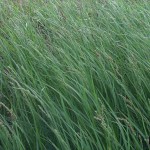Vinemesquite , Vine Mesquite
Panicum obtusum
Poaceae
Description
Vinemesquite is a perennial, warm-season, native species ranging from 12 to 30 inches or 30 cm to 76 cm tall. Produces by long, tough stolons that take root at the woolly nodes. Its rhizomes are short and fibrous, but its stolons may reach up to 10 ft or 3 m long. The erect, flattened stem joints are slick. The top leaf blade clings closely to the narrow seed head. Bloom time occurs from June to August. The inflorescence is densely flowered with a narrow panicle that reaches up to 5 inches or 12 cm long. Seeds turn from green to brown with maturity. Good grazing for livestock that consume the foliage and inflorescence. As the plant ages, it becomes coarser and less palatable for livestock. Fair grazing for wildlife. Seeds are consumed by quail and dove species, and the foliage is consumed by several ruminants and small mammals including deer, pronghorn, elk, jackrabbits, and prairie dogs. Vinemesquite is a larval host for the Dotted Roadside-Skipper butterfly. Due to its density, it also provides cover for a variety of rodents and upland game birds.Habitat
Habitat types include shortgrass prairies, woodlands, and desert grasslands of the Southern United States. Grows along banks of streams or ditches, roadsides, swales, arroyos, on bottomlands, and in depressions of highly productive soils. It can be found in Arkansas, Arizona, Colorado, Missouri, New Mexico, Oklahoma, Texas, and Utah.Images
Plant Characteristics
Seed Type: Non-Encapsulated
Duration: Perennial
Stem Texture: Hairless/Smooth
Growth Habit: Grasses, Sod grass
Leaf Shape
 : Simple with Pinnate or Parallel Venation
: Simple with Pinnate or Parallel Venation
Season: Warm
Distribution
 : 02 - Gulf Prairies and Marshes, 03 - Post Oak Savannah, 04 - Blackland Prairies, 05 - Cross Timbers and Prairies, 06 - South Texas Plains, 07 - Edwards Plateau, 08 - Rolling Plains, 09 - High Plains, 10 - Trans-Pecos
: 02 - Gulf Prairies and Marshes, 03 - Post Oak Savannah, 04 - Blackland Prairies, 05 - Cross Timbers and Prairies, 06 - South Texas Plains, 07 - Edwards Plateau, 08 - Rolling Plains, 09 - High Plains, 10 - Trans-Pecos
Distributions
Distribution refers to the ecological region in Texas that a plant has been found. You can also view a clickable map.
Book: Know Your Grasses (B-182)
Collection: Grasses




